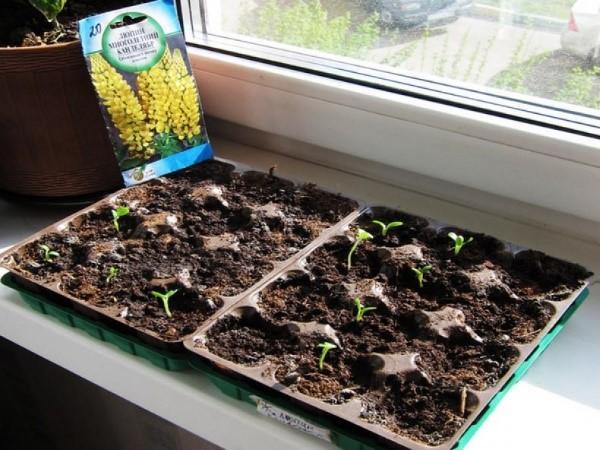Attention, lupine: sowing seeds for seedlings - what you need to know
 Surely you have heard about lupine more than once and seen it in the meadows, but varietal plant species are even more beautiful. Garden lupine, sowing seeds for seedlings of which we will discuss today, is different from meadow lupine. First of all, with its large rocking chairs and bright various colors. But the unpretentiousness of the wild culture was passed on to varietal lupine. It feels good in a flower bed surrounded by our favorite flowers. Despite the fact that the seeds of the plant germinate well when planted in open ground, the seedling method is also used. At the same time, the result is not always so good, but only if you do not take into account some of the features of home growing. What do you need to know to get friendly and strong shoots of lupine seedlings?
Surely you have heard about lupine more than once and seen it in the meadows, but varietal plant species are even more beautiful. Garden lupine, sowing seeds for seedlings of which we will discuss today, is different from meadow lupine. First of all, with its large rocking chairs and bright various colors. But the unpretentiousness of the wild culture was passed on to varietal lupine. It feels good in a flower bed surrounded by our favorite flowers. Despite the fact that the seeds of the plant germinate well when planted in open ground, the seedling method is also used. At the same time, the result is not always so good, but only if you do not take into account some of the features of home growing. What do you need to know to get friendly and strong shoots of lupine seedlings?
Seeds and seedlings are mainly planted with annual lupine. Perennial varieties lose their varietal qualities during seed propagation. On the other hand, you always have a chance to get an interesting new copy.
Preplant seed treatment - is it necessary and what is it
Low seed germination at home is due to the fact that they have a very strong shell. It is difficult for a tender sprout to break through it. At the same time, the beans that have wintered in the garden become softer, undergoing natural stratification. Therefore, when sowing seeds for seedlings, they must be prepared. To do this, put the beans in a cloth bag moistened with water and leave on a platter for a couple of days. When they swell, you can plant them in the ground.
Seedlings will be more robust and develop better if you mix the seeds with a special powder just before sowing. It must be "obtained" by grinding the tubers from the roots of the old lupine growing in the garden. There are nitrogen-fixing bacteria that stimulate the development of seedlings.
Lupine: sowing seeds for seedlings
For growing seedlings, pick up a sufficiently deep container, or even better - separate cups. The plant does not really like transplanting and it is advisable to do without picking. The soil must be taken light and nutritious. For example, a mixture consisting of the following components is suitable:
- sod land;
- peat;
- some sand.
The processed beans will turn into full-fledged bushes, ready for planting in the ground, in about a month or more. Based on this, they need to be planted in March, and in the middle lane - better in April, so as not to overexpose the seedlings indoors. Arrange the beans in pots, after moistening the soil, and cover a little with earth on top. Before emergence, it is advisable to keep crops under a film.
After a week, when the sprouts hatch, remove the film and provide the seedlings with good lighting. There is no need to feed it - lupine develops rapidly. Top dressing will only speed up this process, which will lead to root overgrowth and make it difficult to transplant. Water the plants regularly to keep the soil from drying out.
Try to transplant lupins sown on seedlings into open ground no later than 5 real leaves appear. Overgrown bushes take root worse. Carry out the transplant by the transshipment method, not forgetting that the roots do not like this procedure.